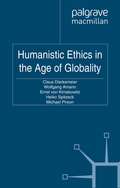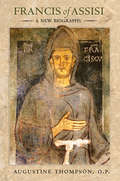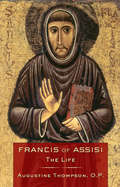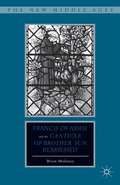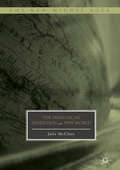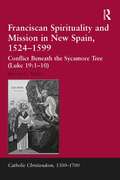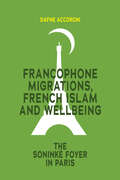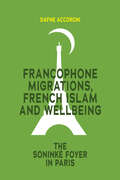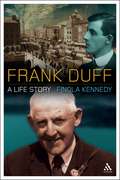- Table View
- List View
Framing Jewish Culture: Boundaries and Representations (Jewish Cultural Studies #4)
by Simon J. BronnerModernity offers people choices about who they want to be and how they want to appear to others. The way in which Jews choose to frame their identity establishes the dynamic of their social relations with other Jews and non-Jews - a dynamic complicated by how non-Jews position the boundaries around what and who they define as Jewish. This book uncovers these processes, historically, as well as in contemporary behavior, and finds explanations for the various manifestations, in feeling and action, of 'being Jewish.' Boundaries and borders raise fundamental questions about the difference between Jews and non-Jews. At root, the question is how 'Jewish' is understood in social situations where people recognize or construct boundaries between their own identity and those of others. The question is important because this is by definition the point at which the lines of demarcation between Jews and non-Jews, and between different groupings of Jews, are negotiated. Collectively, the contributors to the book expand our understanding of the social dynamics of framing Jewish identity. The book opens with an introduction that locates the issues raised by the contributors in terms of the scholarly traditions from which they have evolved. Part I presents four essays dealing with the construction and maintenance of boundaries - two by scholars showing how boundaries come to be etched on an ethnic landscape and two by activists who question and adjust distinctions among neighbors. Part II focuses on expressive means of conveying identity and memory, while, in Part III, the discussion turns to museum exhibitions and festive performances as locations for the negotiation of identity in the public sphere. A lively discussion forum concludes the book with a consideration of the paradoxes of Jewish heritage revival in Poland, and the perception of that revival by Jews and non-Jews. *** ..".these essays help us understand the social dynamics of Jewish identity and how identity is constructed in modern life." -- AJL Reviews, February/March 2015 (Series: Jewish Cultural Studies - Vol. 4) [Subject: Jewish Studies, Cultural Studies]
Framing Mary: The Mother of God in Modern, Revolutionary, and Post-Soviet Russian Culture (NIU Series in Slavic, East European, and Eurasian Studies)
by Adams, Amy Singleton; Shevzov, VeraDespite the continued fascination with the Virgin Mary in modern and contemporary times, very little of the resulting scholarship on this topic extends to Russia. Russia's Mary, however, who is virtually unknown in the West, has long played a formative role in Russian society and culture. Framing Mary introduces readers to the cultural life of Mary from the seventeenth century to the post-Soviet era. It examines a broad spectrum of engagements among a variety of people—pilgrims and poets, clergy and laity, politicians and political activists—and the woman they knew as the Bogoroditsa. In this collection of well-integrated and illuminating essays, leading scholars of imperial, Soviet, and post-Soviet Russia trace Mary's irrepressible pull and inexhaustible promise from multiple disciplinary perspectives. Focusing in particular on the ways in which both visual and narrative images of Mary frame perceptions of Russian and Soviet space and inform discourse about women and motherhood, these essays explore Mary's rich and complex role in Russia's religion, philosophy, history, politics, literature, and art. Framing Mary will appeal to Russian studies scholars, historians, and general readers interested in religion and Russian culture.
Framing Muslims: Stereotyping and Representation after 9/11
by Peter Morey Amina YaqinIn Framing Muslims: Stereotyping and Representation after 9/11, Peter Morey and Amina Yaqin dissect how stereotypes that depict Muslims as an inherently problematic presence in the West are constructed, deployed, and circulated in the public imagination, producing an immense gulf between representation and a considerably more complex reality.
The Framing of Sacred Space: The Canopy and the Byzantine Church
by Jelena BogdanovicThe Framing of Sacred Space offers the first topical study of canopies as essential spatial and symbolic units in Byzantine-rite churches. Centrally planned columnar structures--typically comprised of four columns and a roof--canopies had a critical role in the modular processes of church design, from actual church furnishings in the shape of a canopy to the church's structural core. As architectonic objects of basic structural and design integrity, canopies integrate an archetypical image of architecture and provide means for an innovative understanding of the materialization of the idea of the Byzantine church and its multi-focal spatial presence. The Framing of Sacred Space considers both the material and conceptual framing of sacred space and explains how the canopy bridges the physical and transcendental realms. As a crucial element of church design in the Byzantine world, a world that gradually abandoned the basilica as a typical building of Roman imperial secular architecture, the canopy carried tectonic and theological meanings and, through vaulted, canopied bays and recognizable Byzantine domed churches, established organic architectural, symbolic, and sacred ties between the Old and New Covenants. In such an overarching context, the canopy becomes an architectural parti, a vital concept and dynamic design principle that carries the essence of the Byzantine church. The Framing of Sacred Space highlights significant factors in understanding canopies through specific architectural settings and the Byzantine concepts of space, thus also contributing to larger debates about the creation of sacred space and related architectural taxonomy.
The Framing of Sacred Space: The Canopy and the Byzantine Church
by Jelena BogdanovicThe Framing of Sacred Space offers the first topical study of canopies as essential spatial and symbolic units in Byzantine-rite churches. Centrally planned columnar structures--typically comprised of four columns and a roof--canopies had a critical role in the modular processes of church design, from actual church furnishings in the shape of a canopy to the church's structural core. As architectonic objects of basic structural and design integrity, canopies integrate an archetypical image of architecture and provide means for an innovative understanding of the materialization of the idea of the Byzantine church and its multi-focal spatial presence. The Framing of Sacred Space considers both the material and conceptual framing of sacred space and explains how the canopy bridges the physical and transcendental realms. As a crucial element of church design in the Byzantine world, a world that gradually abandoned the basilica as a typical building of Roman imperial secular architecture, the canopy carried tectonic and theological meanings and, through vaulted, canopied bays and recognizable Byzantine domed churches, established organic architectural, symbolic, and sacred ties between the Old and New Covenants. In such an overarching context, the canopy becomes an architectural parti, a vital concept and dynamic design principle that carries the essence of the Byzantine church. The Framing of Sacred Space highlights significant factors in understanding canopies through specific architectural settings and the Byzantine concepts of space, thus also contributing to larger debates about the creation of sacred space and related architectural taxonomy.
Framing the Jina: Narratives of Icons and Idols in Jain History
by John CortJohn Cort explores the narratives by which the Jains have explained the presence of icons of Jinas (their enlightened and liberated teachers) that are worshiped and venerated in the hundreds of thousands of Jain temples throughout India. Most of these narratives portray icons favorably, and so justify their existence; but there are also narratives originating among iconoclastic Jain communities that see the existence of temple icons as a sign of decay and corruption. The veneration of Jina icons is one of the most widespread of all Jain ritual practices. Nearly every Jain community in India has one or more elaborate temples, and as the Jains become a global community there are now dozens of temples in North America, Europe, Africa, and East Asia. The cult of temples and icons goes back at least two thousand years, and indeed the largest of the four main subdivisions of the Jains are called Murtipujakas, or "Icon Worshipers." A careful reading of narratives ranging over the past 15 centuries, says Cort, reveals a level of anxiety and defensiveness concerning icons, although overt criticism of the icons only became explicit in the last 500 years. He provides detailed studies of the most important pro- and anti-icon narratives. Some are in the form of histories of the origins and spread of icons. Others take the form of cosmological descriptions, depicting a vast universe filled with eternal Jain icons. Finally, Cort looks at more psychological explanations of the presence of icons, in which icons are defended as necessary spiritual corollaries to the very fact of human embodiedness.
Framing the Jina: Narratives of Icons and Idols in Jain History
by John CortJohn Cort explores the narratives by which the Jains have explained the presence of icons of Jinas (their enlightened and liberated teachers) that are worshiped and venerated in the hundreds of thousands of Jain temples throughout India. Most of these narratives portray icons favorably, and so justify their existence; but there are also narratives originating among iconoclastic Jain communities that see the existence of temple icons as a sign of decay and corruption. The veneration of Jina icons is one of the most widespread of all Jain ritual practices. Nearly every Jain community in India has one or more elaborate temples, and as the Jains become a global community there are now dozens of temples in North America, Europe, Africa, and East Asia. The cult of temples and icons goes back at least two thousand years, and indeed the largest of the four main subdivisions of the Jains are called Murtipujakas, or "Icon Worshipers." A careful reading of narratives ranging over the past 15 centuries, says Cort, reveals a level of anxiety and defensiveness concerning icons, although overt criticism of the icons only became explicit in the last 500 years. He provides detailed studies of the most important pro- and anti-icon narratives. Some are in the form of histories of the origins and spread of icons. Others take the form of cosmological descriptions, depicting a vast universe filled with eternal Jain icons. Finally, Cort looks at more psychological explanations of the presence of icons, in which icons are defended as necessary spiritual corollaries to the very fact of human embodiedness.
France and the Mass Media (Warwick Studies in the European Humanities)
by Nicholas Hewitt Brian RigbyIn this volume specialists from Britain and France adopt a fresh approach to the study of French culture since 1945 by focusing on the mass media and on a whole range of popular cultural forms. As well as introducing English-speaking readers to such new fields as French radio, television, science fiction and popular song, this volume also highlights how the French themselves responded to the growing importance of the mass media in postwar France.
Francis: From Argentina’s Bergoglio to the World’s Francis
by Jimmy BurnsFrom the moment Pope Francis stepped on to the balcony of St Peter's Basilica for the first time, a global audience sensed that not only the Catholic Church but the world at large could be entering a new spiritual, political and social age. In the days following Pope Francis' election, there would be further early signs of the simplicity worthy of the first apostles and the leader that inspired them. Not since John XIII appeared on the scene half a century earlier had a new Pope opened the windows of the Church in such a way as to let in some much needed fresh air. Nevertheless, for the excitement generated by the first Latin American Pope and a man who claimed to want to put the poor back at the centre of the Church's social teaching, people could still only guess where it might be all be leading.Francis: Pope of Good Promise is neither an instant media job, nor a hagiography based on authorised interviews, but the product of diligent investigation across a wide range of official and independent sources - a measured, objective portrait of a man who, in circumstances that he neither sought nor foresaw, found himself handed the highest office at a time of crisis not just for the Church but for long established institutions worldwide from banks to political parties.
Francis Huxley: Ein Leben für die Sozialanthropologie
by Theodor Itten Ron RobertsDieses Buch über das Leben und Werk von Francis Huxley (1923–2016) zeichnet zugleich die Suche nach dem Verständnis der Conditio humana nach und nimmt seine Leserinnen und Leser mit auf eine biografische, philosophische, kulturelle, historische, politische und epistemologische Erkundungsreise.Als Mitglied der berühmten Huxley-Dynastie leistete Francis Huxley wichtige und innovative Beiträge zur Sozialanthropologie, zur Pflege der psychischen Gesundheit und zum Schutz indigener Völker. Seine ungewöhnliche Laufbahn und Lebensgeschichte zeigen, wie die Produktion und Verbreitung von Ideen in einem intergenerationellen und soziologischen Kontext verstanden werden kann. Das Buch reflektiert die zeitgenössische Relevanz von Huxleys Werk und stellt Verbindungen her zwischen den zentralen philosophischen, kulturellen, wissenschaftlichen und politischen Themen des turbulenten frühen 21. Jahrhunderts und den überdauernden Fragen, die die Menschen auf der Suche nach dem Verständnis ihrer selbst und ihres Platzes in der Welt antreiben. Dieses Buch ist für alle Studierenden, Forschenden und Lehrenden der Sozial- und Geisteswissenschaften von Interesse.Dieses Buch ist eine gründliche und faszinierende Darstellung des Lebens meines Onkels Francis, mit all seinen Schatten und Sonnenseiten. Die Autoren beschreiben seinen sprunghaften Charakter gut. Sie geben eine genaue Einschätzung seines Lebenswerkes und seiner Schriften Victoria Huxley, Nichte. Diese Studie über Francis Huxley ist willkommen und überfällig, denn er war einer der größten Sozialanthropologen der indigenen Völker Amazoniens. Seine Beobachtungen waren gründlich, wissenschaftlich korrekt und entsprachen den höchsten Standards seiner Disziplin. Huxley war in zweierlei Hinsicht außergewöhnlich. Sein reizvoller Schreibstil vermittelte seine Leidenschaft sowohl den allgemeinen LeserInnen als auch den WissenschaftlerInnen. Er war mir ein herzlicher Freund, den Menschen der indigenen Völker, die er studierte, wie ein dazugehöriger. Francis war fasziniert von deren Mythologien und ihren geistigen sowie spirituellen Welten. Er konnte sich gut in sie einfühlen und dachte fast wie einer von ihnen. John Hemming, Autor von Menschen des Regenwaldes Dies ist ein ungemein fesselndes und packendes Buch. Nachdenklich und gut geschrieben, vermittelt es gekonnt und mit großem Einfühlungsvermögen die vielen faszinierenden Schichten von Francis Huxley, sein reiches und vielfältiges Leben, sowie seine Vorlieben und seine Philosophie. Fiona Watson, Survival International
Francis of Assisi: A New Biography
by Augustine ThompsonAmong the most beloved saints in the Catholic tradition, Francis of Assisi (c. 1181–1226) is popularly remembered for his dedication to poverty, his love of animals and nature, and his desire to follow perfectly the teachings and example of Christ. During his lifetime and after his death, followers collected, for their own purposes, numerous stories, anecdotes, and reports about Francis. As a result, the man himself and his own concerns became lost in legend.In this authoritative and engaging new biography, Augustine Thompson, O.P., sifts through the surviving evidence for the life of Francis using modern historical methods. The result is a complex yet sympathetic portrait of the man and the saint. Francis emerges from this account as very much a typical thirteenth-century Italian layman, but one who, when faced with unexpected crises in his personal life, made decisions so radical that they challenge his own society—and ours. Unlike the saint of legend, this Francis never had a unique divine inspiration to provide him with rules for following the teachings of Jesus. Rather, he spent his life reacting to unexpected challenges, before which he often found himself unprepared and uncertain. The Francis who emerges here is both more complex and more conflicted than that of older biographies. His famed devotion to poverty is found to be more nuanced than expected, perhaps not even his principal spiritual concern. Thompson revisits events small and large in Francis's life, including his troubled relations with his father, his contacts with Clare of Assisi, his encounter with the Muslim sultan, and his receiving the Stigmata, to uncover the man behind the legends and popular images.A tour de force of historical research and biographical writing, Francis of Assisi: A New Biography is divided into two complementary parts—a stand alone biographical narrative and a close, annotated examination of the historical sources about Francis. Taken together, the narrative and the survey of the sources provide a much-needed fresh perspective on this iconic figure. "As I have worked on this biography," Thompson writes, "my respect for Francis and his vision has increased, and I hope that this book will speak to modern people, believers and unbelievers alike, and that the Francis I have come to know will have something to say to them today."
Francis of Assisi: The Life
by Augustine ThompsonThis elegant and accessible biography of one of Catholicism's most beloved saints was originally published as Part 1 of Francis of Assisi: A New Biography by Augustine Thompson, O.P. It stands alone as a richly informed portrait of a man whose complex faith and commitment continue to inspire today. An introduction by Thompson places his biography in the context of continuing discussions about Francis's legacy, particularly the new Pope's decision to adopt the saint's name.
Francis of Assisi and His “Canticle of Brother Sun” Reassessed (The New Middle Ages)
by B. MoloneyBringing the skills of a literary historian to the subject, Brian Moloney considers the genesis of Saint Francis of Assisi's Canticle of Brother Sun to show how it works as a carefully composed work of art. The study examines the saint's life and times, the structure of the poem, the features of its style, and the range of its possible meanings.
Franci's War: The incredible true story of one woman's survival of the Holocaust
by Franci EpsteinWhat are you willing to do to survive? What are you willing to endure if it means you might live? 'A story that neads to be heard' 5***** Reader Review Entering Terezin, a Nazi concentration camp, Franci was expected to die. She refused.In the summer of 1942, twenty-two-year-old Franci Rabinek - designated a Jew by the Nazi racial laws - arrived at Terezin, a concentration camp and ghetto forty miles north of her home in Prague. It would be the beginning of her three-year journey from Terezin to the Czech family camp in Auschwitz-Birkenau, to the slave labour camps in Hamburg, and finally to Bergen Belsen. Franci, a spirited and glamorous young woman, was known among her fellow inmates as the Prague dress designer. Having endured the transportation of her parents, she never forgot her mother's parting words:'Your only duty to us is to stay alive'.During an Auschwitz selection, Franci would spontaneously lie to Nazi officer Dr Josef Mengele, and claim to be an electrician.A split-second decision that would go on to endanger - and save - her life. Unpublished for 50 years, Franci's War is an astonishing account of one woman's attempt to survive those dark years. Heartbreaking, candid, and sometimes unbearably funny, she gives voice to the women prisoners in her tight-knit circle of friends. Her testimony sheds new light on the alliances, love affairs, and sexual barter that took place during the Holocaust, offering a compelling insight into the resilience and courage of ordinary people in an extraordinary situation.Above all, Franci's War asks us to explore what it takes to survive, and what it means to truly live.'Fascinating and traumatic. Well worth a read' 5***** Reader Review'A candid account of shocking events. Franci is someone many women today will be able to identify with' 5***** Reader Review
The Franciscan Invention of the New World
by Julia McclureThis book examines the story of the ‘discovery of America’ through the prism of the history of the Franciscans, a socio-religious movement with a unique doctrine of voluntary poverty. The Franciscans rapidly developed global dimensions, but their often paradoxical relationships with poverty and power offer an alternate account of global history. Through this lens, Julia McClure offers a deeper history of colonialism, not only by extending its chronology, but also by exploring the powerful role of ambivalence in the emergence of colonial regimes. Other topics discussed include the legal history of property, the complexity and politics of global knowledge networks, the early (and neglected) history of the Near Atlantic, and the transatlantic inquisition, mysticism, apocalypticism, and religious imaginations of place.
The Franciscan Invention of the New World
by Julia McclureThis book examines the story of the ‘discovery of America’ through the prism of the history of the Franciscans, a socio-religious movement with a unique doctrine of voluntary poverty. The Franciscans rapidly developed global dimensions, but their often paradoxical relationships with poverty and power offer an alternate account of global history. Through this lens, Julia McClure offers a deeper history of colonialism, not only by extending its chronology, but also by exploring the powerful role of ambivalence in the emergence of colonial regimes. Other topics discussed include the legal history of property, the complexity and politics of global knowledge networks, the early (and neglected) history of the Near Atlantic, and the transatlantic inquisition, mysticism, apocalypticism, and religious imaginations of place.
Franciscan Spirituality and Mission in New Spain, 1524-1599: Conflict Beneath the Sycamore Tree (Luke 19:1-10) (Catholic Christendom, 1300-1700)
by Steven E. TurleyFranciscans in sixteenth-century New Spain were deeply ambivalent about their mission work. Fray Juan de Zumárraga, the first archbishop of Mexico, begged the king to find someone else to do his job so that he could go home. Fray Juan de Ribas, one of the original twelve 'apostles of Mexico' and a founding pillar of the church in New Spain, later fled with eleven other friars into the wilderness to escape the demands of building that church. Fray Jerónimo de Mendieta, having returned from an important preaching tour in New Spain, wrote to his superior that he did not want to enlist again, and that the only way he would return to the mission field was if God dragged him by the hair. This discontent was widespread, grew stronger with time, and carried important consequences for the friars' interactions with indigenous peoples, their Catholic co-laborers, and colonial society at large. This book examines that discontent and seeks to explain why the exhilaration of joining such a 'glorious' enterprise so often gave way to grinding discontent. The core argument is that, despite St. Francis's own longing to do mission work, his followers in New Spain found that effective evangelization in a frontier context was fundamentally incompatible with their core spirituality. Bringing together two streams of historiography that have rarely overlapped - spirituality and missions - this book marks a strong contribution to the history of spirituality in both Latin America and Europe, as well as to the growing fields of transatlantic and world history.
Franciscan Spirituality and Mission in New Spain, 1524-1599: Conflict Beneath the Sycamore Tree (Luke 19:1-10) (Catholic Christendom, 1300-1700)
by Steven E. TurleyFranciscans in sixteenth-century New Spain were deeply ambivalent about their mission work. Fray Juan de Zumárraga, the first archbishop of Mexico, begged the king to find someone else to do his job so that he could go home. Fray Juan de Ribas, one of the original twelve 'apostles of Mexico' and a founding pillar of the church in New Spain, later fled with eleven other friars into the wilderness to escape the demands of building that church. Fray Jerónimo de Mendieta, having returned from an important preaching tour in New Spain, wrote to his superior that he did not want to enlist again, and that the only way he would return to the mission field was if God dragged him by the hair. This discontent was widespread, grew stronger with time, and carried important consequences for the friars' interactions with indigenous peoples, their Catholic co-laborers, and colonial society at large. This book examines that discontent and seeks to explain why the exhilaration of joining such a 'glorious' enterprise so often gave way to grinding discontent. The core argument is that, despite St. Francis's own longing to do mission work, his followers in New Spain found that effective evangelization in a frontier context was fundamentally incompatible with their core spirituality. Bringing together two streams of historiography that have rarely overlapped - spirituality and missions - this book marks a strong contribution to the history of spirituality in both Latin America and Europe, as well as to the growing fields of transatlantic and world history.
Franciscan Writings: Hope amid Ecological Sin and Climate Emergency
by Dawn M. OSFThis book explains key Franciscan values and a hope-filled vision of peace, justice, and sustainability for all of creation. Dawn M. Nothwehr engages with a wide variety of topics such as: ecological sin, environmental destruction, a positive Franciscan soteriological path forward, practical tools necessary for conversion, planet-healing actions, and life-sustaining changes. Part 1 includes two chapters on the Old and New Testament texts frequently utilized by St. Francis and St. Clare that uphold values essential for Franciscan ecotheology. Part 2 features a chapter on St. Francis and one on St. Clare, mapping the distinct major landmarks of their vernacular theologies on creation care. The two chapters of Part 3 first outline the formal Franciscan theology and spirituality of St. Bonaventure of Bagnoregio, before diving into the Christology and ethics of Blessed John Duns Scotus. In four chapters, Part 4 focuses on major ecological issues with an interdisciplinary approach considering current science, Franciscan theology, ethics, spirituality and praxis.Designed for classroom use, each chapter includes a wide variety of pedagogical features: primary texts, reflection and application, questions for reflection and discussion, suggestions for action, a short prayer and suggestions for further study.
Franciscan Writings: Hope amid Ecological Sin and Climate Emergency
by Dawn M. OSFThis book explains key Franciscan values and a hope-filled vision of peace, justice, and sustainability for all of creation. Dawn M. Nothwehr engages with a wide variety of topics such as: ecological sin, environmental destruction, a positive Franciscan soteriological path forward, practical tools necessary for conversion, planet-healing actions, and life-sustaining changes. Part 1 includes two chapters on the Old and New Testament texts frequently utilized by St. Francis and St. Clare that uphold values essential for Franciscan ecotheology. Part 2 features a chapter on St. Francis and one on St. Clare, mapping the distinct major landmarks of their vernacular theologies on creation care. The two chapters of Part 3 first outline the formal Franciscan theology and spirituality of St. Bonaventure of Bagnoregio, before diving into the Christology and ethics of Blessed John Duns Scotus. In four chapters, Part 4 focuses on major ecological issues with an interdisciplinary approach considering current science, Franciscan theology, ethics, spirituality and praxis.Designed for classroom use, each chapter includes a wide variety of pedagogical features: primary texts, reflection and application, questions for reflection and discussion, suggestions for action, a short prayer and suggestions for further study.
The Franciscans And Art Patronage In Late Medieval Italy (PDF)
by Louise BourduaIn this book, Louise Bourdua examines how Franciscan church decoration developed between 1250 and 1400. Focusing on three important churches - San Fermo Maggiore, Verona, San Lorenzo, Vicenza and Sant'Antonio, Padua - she argues that local Franciscan friars were more interested in their own conception of how artistic programs should work than merely following models for decoration issued from the mother church at Assisi. In addition, lay patrons also had considerable input into the decoration programs. These case studies serve as a multiform model of patronage, which is tested against other commissions of the Trecento.
The Franciscans And Art Patronage In Late Medieval Italy (PDF)
by Louise BourduaIn this book, Louise Bourdua examines how Franciscan church decoration developed between 1250 and 1400. Focusing on three important churches - San Fermo Maggiore, Verona, San Lorenzo, Vicenza and Sant'Antonio, Padua - she argues that local Franciscan friars were more interested in their own conception of how artistic programs should work than merely following models for decoration issued from the mother church at Assisi. In addition, lay patrons also had considerable input into the decoration programs. These case studies serve as a multiform model of patronage, which is tested against other commissions of the Trecento.
Francophone Migrations, French Islam and Wellbeing: The Soninké Foyer in Paris
by Dafne AccoroniAddressing several issues of significance in the fields of Anthropology of Migration, Politics of Healthcare, Religious and Francophone Studies, this book pursues an unprecedented line of research by bringing to the fore the geopolitical dimension of francophonie, understood as a political construct, as much as a cultural, artistic and a linguistic space, with French as common language. The book is based on participant observation carried out in Paris in a foyer among Soninké migrants, the principal ethnographic focus, and at the secondary field-site based at the Mouride Islamic Centre of Taverny, which serves to show an important facet of the so-called Francophone Islam.
Francophone Migrations, French Islam and Wellbeing: The Soninké Foyer in Paris
by Dafne AccoroniAddressing several issues of significance in the fields of Anthropology of Migration, Politics of Healthcare, Religious and Francophone Studies, this book pursues an unprecedented line of research by bringing to the fore the geopolitical dimension of francophonie, understood as a political construct, as much as a cultural, artistic and a linguistic space, with French as common language. The book is based on participant observation carried out in Paris in a foyer among Soninké migrants, the principal ethnographic focus, and at the secondary field-site based at the Mouride Islamic Centre of Taverny, which serves to show an important facet of the so-called Francophone Islam.
Frank Duff: A Life Story
by Finola KennedyThe Irish Times described Frank Duff as 'the founder of the largest international association that has originated in Ireland. Yet he has been, among Irish leaders of his generation, the least publicised.' Duff was not only a major religious figure; he also had a distinct influence on the evolution of modern Irish society. A friend of Irish leaders including Michael Collins, W. T. Cosgrave and Éamon de Valera, he avoided the cult of celebrity which might well have befallen him as the founder of an organisation which today has over four million active members and ten million auxiliary members in more than one hundred and seventy countries. Like most saintly people, his greatest opposition came from local Church figures and this is a vital part of the story.





